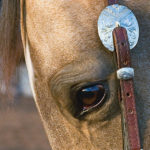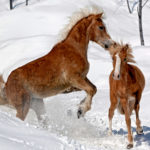When you lead a busy life, finding time for horses can sometimes seem like a challenge. Yet, because our equine partners help us relax and find moments of peace in our fast-paced, stressful lives, horse time can be the perfect prescription for releasing some of that stress.

Here are eight great ways to unwind with your horse, complete with a time component to help you see how they fit into your schedule, and comments from real riders. Some may work for you better than others, but you can customize them to fit your schedule and life, and your horse’s needs.
1. Stress Releaser:Mucking Stalls/Cleaning Pens
Time required: From 15 minutes to pick out one relatively clean stall or paddock to a couple of hours for multiple stalls/pens.

Why it works: Exercising reduces mental stress. You get a sense of accomplishment by seeing progress as you clean, and comfort from knowing you’re making life better for your horse. This is a chore that must be done, so instead of dreading it, view it as a relaxing exercise. To help this duty fly by, you can work quietly with your own thoughts, converse with a helper, or listen to music from your device of choice.
Side benefit: While cleaning, you have a chance to check your horse’s living quarters for anything unsafe, such as loose boards, protruding nails, leaking pipes, etc. It’s also a chance to see if holes need filling, mats need replacing, and waterers are working as they should.
Avoid: Broken equipment if possible. That manure fork with missing tines, muck tub with broken handles, or wheelbarrow with a flat tire will cause only more stress.
Real riders say: “Just spending time with my horses, including mucking stalls, makes me happy!”—Heather Gallagher Holmes, Vermont.
“Spending quiet time cleaning stalls, especially when the horses are munching on their dinners, makes me feel calm.”—Nadine Webb, California.
2. Stress Releaser: Grooming
Time required: From 15 minutes for a quick currying and brushing to a couple of hours for a show-ready turnout.

Why it works: Grooming incorporates physical activity and a hands-on experience with your horse. The rhythmic motions can help melt tension away. There’s something deeply satisfying about grooming, as it lets you bond with your horse while making him look his best. Most horses enjoy a grooming session, and you can enhance the experience by massaging him in his favorite spots.
Side benefit: Grooming can act as a health check-up for your horse. Look for scrapes and cuts, swellings, insect bites, sheath and udder cleanliness, and tail rubbing; treat as necessary.
Avoid: Bad timing and spooky places. Though grooming can provide a training opportunity as your horse learns to behave through a session, avoid grooming in a place or at a time that makes him tense. You may be OK with the landscape team’s weed whacker and leaf blower, but if your horse objects, your session can go from relaxing to stressful in a blink.
Real riders say: “I love to groom my horse from top to bottom! Plus, he loves the massage. It’s so relaxing to just take my time making him feel good.”—Kristyn Snyder, Missouri.
“Bathing and grooming head to hoof, mane and tail…I love that, and so does my mare.”—Lori Gianforte, Arizona.
3. Stress Releaser: Longeing
Time required: About 20 to 30 minutes.
Why it works: Longeing yields a very high satisfaction rate for most people because it’s a relatively simple yet immensely functional activity. The beautiful motion of your horse traveling around you can be nearly mesmerizing, yet you can feel a solid sense of accomplishment that he’s benefiting on two levels: His body is exercising and his brain is engaged. Longeing can solve two issues for you, too. It’s a fantastic way of exercising your horse if you don’t have time to tack up and ride, or if a physical problem prevents you from riding. It also can be a great training method, reinforcing your position as your horse’s trusted and respected boss. For safety, wear gloves and solid, barn-worthy footwear.
Side benefit: From the center of your circle, longeing is a great way to assess whether your horse is stiff and lame or fluid and sound.
Avoid: Bad footing, unfenced areas, tangled longe lines—all can lead to disaster. Bad footing can lead to an injured horse, an unfenced area can lead to a loose horse with a deadly longe line still attached, and a tangled longe line can cause you to lose fingers or be dragged.
Real riders say: “Ground work with my horses relaxes me. I was a trainer for 25 years until I had an accident and could no longer ride, so longeing is one of my ‘peaceful places’ and calms me down.”—Kim Farris, Florida.
“If I don’t have time to saddle up and ride, I’ll longe for 20 minutes and feel satisfied that at least my horse got some exercise.”—Jennifer Sharp, Michigan.
4. Stress Releaser: Hand-Grazing
Time required: Even 15 minutes can relax you, but your horse would love an hour.
Why it works: This can be done with nearly any horse, but is especially helpful if riding, longeing, or even turnout is out of the picture, as with a horse recuperating from injury. Hand-grazing your horse is a great way of spending quality, tranquil time together. You both can relax as he moseys about, nibbling. These peaceful moments are especially lovely in great weather.
Side benefit: Similar to turnout time, hand-grazing lets your horse decompress if he’s been stall-bound. But better than turnout, it provides a bonding session for the two of you and a chance to observe him up close.
Avoid: Zoning out. You still have a horse at the end of the lead line, so stay aware. If he spooks while you’re daydreaming, you could be injured and he could pull free and run loose, possibly injuring himself or others.
Real riders say: “My horse is my means for managing stress. Rides are the best, but getting her out to graze on the lawn works well in a pinch, and brings my blood pressure down a few notches.”—Rosemary Jenkins, California.
“Hand-grazing provides such a calming connection between horse and human that I can almost sense my tension leaving, as if it’s absorbed by the lead rope and cast aside.”—Theresa Wolcott Leri, Washington.
5. Stress Releaser: Tack Maintenance
Time required: From 30 minutes for a quick cleaning of a saddle and bridle to a few hours for more intensive equipment maintenance or a floor-to-ceiling tackroom cleaning.
Why it works: Cleaning and caring for equipment helps keep your horse comfortable and healthy, and if done regularly, can spare you a larger job later. Keeping your horse’s wardrobe clean and well cared for can provide a sense of accomplishment and relief (when you need that bridle or stable sheet, it’s clean, in good repair, and waiting for use). Organizing your tack trunk or tackroom is also a great hands-on job that can be soothing and rewarding. You’ll remind yourself of what you have, what needs replacing or repairing, and know where everything is. You may even devise a new organization method.
Side benefit: Caring for and properly storing equipment helps preserve it, therefore helping it perform better and last longer. Keeping a clean tack room roots out rodents and can save your equipment.
Avoid: Wearing nice clothes. As your tack and tack room get cleaner, you’re likely to get dirtier, and if you’re wearing good clothes, you could rocket right back into the stress zone.
Real riders say: “I love cleaning my tack. It’s therapeutic—very calming and soothing—and I love putting on clean tack when I saddle up.”
—Annina Micheli, California.
“I pride myself on keeping my tack in good shape, and know it’s saving me headaches and money in the future.”—Jessica Mendell, Oklahoma.
6. Stress Releaser: Trail Riding
Time required: One hour to a whole day, depending on location and destination.
Why it works: Trail riding is a bit like a miniature vacation with the company of your horse. For legions of horse people, trail riding is an overwhelming favorite way to relax and their primary reason for having a horse. From brief jaunts around the back 40 to daylong treks in the desert, forest, or mountains, trail rides and their opportunities to escape real-world pressures are endlessly varied. Add some friends, and it can be a great horsey social experience, too.
Side benefit: It’s a great break from arena work for your horse, too. You can apply some training to your trail ride, but overall, it’s a nice way to let him enjoy himself.
Avoid: Going out if your horse isn’t behaving well enough for you to enjoy yourself. It could be dangerous at worst, and simply no fun for either of you at best.
Real riders say: “I like to trail ride with friends. Nothing else matters when I’m in the saddle—no worries!”—Carla Miller, Texas.
“Riding in the woods, I sing a lot to my horse, as well as breathe in all the different smells of the forest. Total relaxation and no stress.”—Jill Petersen, Denmark.
7. Stress Releaser: Spare Moments With Your Horse
Time required: Any time that you can make, from 10 minutes to all day.

Why it works: Immersing yourself in the sights, sounds, and smells of your horse’s lifestyle can be the ultimate relaxation. Spending random moments with him helps the two of you bond, and allows you to learn more about him while enjoying his animal magnetism. These moments may include simply standing with him while the farrier works on him, sitting near him while he eats a meal, or turning him out, pulling up a chair at the fence and watching as he grazes, rolls, or interacts with pasturemates.
Side benefit: These non-demanding times will reinforce to your horse that you’re a peaceful presence and that he can relax around you.
Avoid: Intruding. Be mindful of not interrupting his sleep or disturbing him as he tries to eat. Even the most gentle of horses can kick at such moments.
Real riders say: “Some days I just put a lawn chair in the aisle and read the paper while the horses eat. It’s very soothing.”—Heidi Henry, Illinois.
“After a frustrating day at work, I just need to step one foot into the barn to feel the stress leave my body. It gets even better when I walk up to the paddock and my horse leaves his hay and walks over to meet me! It doesn’t get any better than that!”—Theresa Robinson, Ontario.
8. Stress Releaser: Training Session
Time required: About an hour.
Why it works: When you tackle a training session from a relaxed, confident perspective, you can do wonders for yourself and your horse. The key to success, and the satisfaction that comes with it, is recognizing your session as a step in a larger process, not expecting final results, and not drilling your horse excessively. With this attitude, you’ll feel a sense of accomplishment if your horse gives you even a hint of grasping a concept.
Side benefit: After a series of these sessions, your horse should grasp what you’re aiming for.
Avoid: Forcing the issue, working your horse too long, or expecting too much from one session, as these training errors are stressful to you both.
Real riders say: “Arena work is relaxing when my goal for the day is met.”—Kathleen Waltemire, Pennsylvania.
“Working with any of my colts, and even the older trained horses and teaching them something new, is the way that I relax and relieve stress from the day.”—Gloria Kadlec, Saskatchewan.





